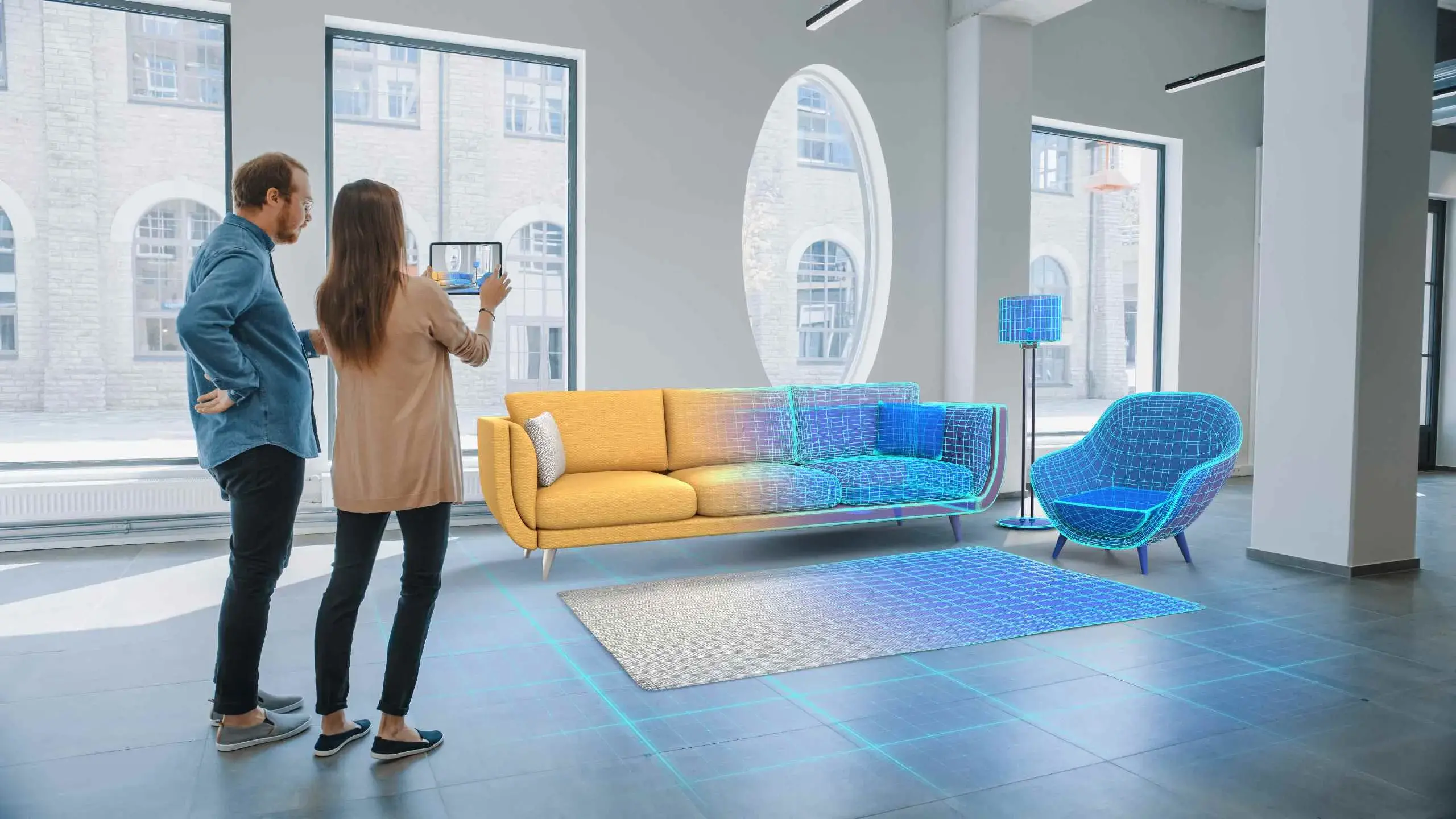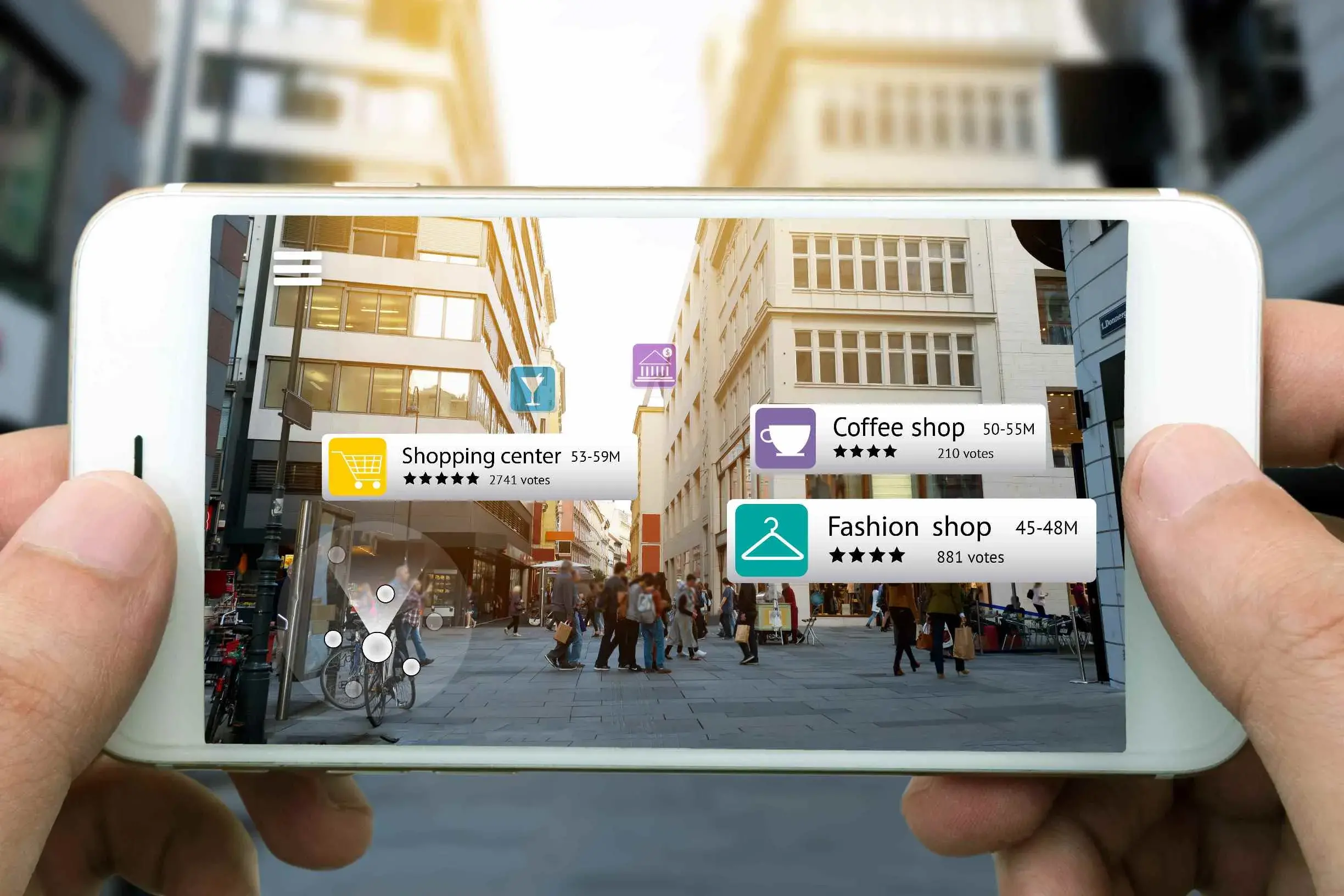Have you ever imagined a world where you could try on clothes without stepping into a fitting room or seeing how furniture looks in your living room before buying it? That's the magic of Augmented Reality (AR), a technology that brings digital experiences into our real world.
In this article, we will explore how AR is shaking up the tech scene and how it is set to revolutionize online shopping, making it more exciting and personalized than ever before. So, let's dive in and discover the future of shopping with AR!
What is Augmented Reality?
Augmented Reality, or AR, is a technology that adds digital content—like pictures, videos, 3D models, or information—onto what we see in the real world, as it happens. It improves how we see and experience the physical world by putting in things created by computers that we can interact with.
Imagine you're looking at a street through your smartphone camera, and on the screen, you see information pop up about the shops and restaurants you're looking at.
Or, think about playing a video game where cartoon monsters appear in your living room, and you can catch them as if they were really there. AR blends the digital and real worlds, making it feel like these extra bits of information or fun characters are part of your everyday environment.
Augmented reality (AR) is a cool new technology that is changing how we see and play with digital stuff. It is not just for geeks; it is also helping lots of businesses, like eCommerce, become more awesome. It is integrating virtual elements into the real-world environment.
AR enhances our sensory experiences by using devices like smartphones, tablets, or specialized AR headsets. The growing popularity of AR is thanks to improvements in hardware and software, as well as greater accessibility to these technologies for the general public.
Some History of AR
The history of AR can be traced back to the 1960s when computer scientists started experimenting with early interactive displays. The term "augmented reality" was coined in the early 1990s. Over the decades, AR technology has evolved significantly, resulting in the development of various AR applications and devices.
Today, AR has transitioned from being a concept in science fiction to an everyday technology. It has found success in various fields, including gaming, healthcare, education, and manufacturing. However, its most significant potential impact could be in the realm of ecommerce.
Ecommerce has transformed how we shop, making it more convenient and accessible. The global online retail market has grown exponentially, driven by factors such as convenience, choice, and competitive pricing. But AR is set to take ecommerce to the next level.
Key Characteristics of Augmented Reality

Real-World Integration: AR overlays digital information or objects onto the real-world environment, blending the virtual with the physical.
Interactive: Users can interact with AR elements, such as moving, resizing, or manipulating them in real-time.
Sensory Enhancement: AR enhances our sensory experiences by adding visual, auditory, or haptic feedback to the real world.
Device Dependent: AR typically requires devices like smartphones, tablets, or AR glasses to access and experience the augmented content.
Contextual: AR adapts to the user's environment, providing contextually relevant information or objects based on their surroundings.
Real-Time: AR content is generated and displayed in real-time, allowing for immediate interaction and feedback.
Location Awareness: Some AR systems use GPS or other location-based technologies to provide location-specific content.
Marker-Based and Markerless: AR can be marker-based, where it relies on predefined markers or objects, or markerless, using computer vision to recognize and augment the environment without specific markers.
Multi-Sensory: AR can engage multiple senses, not just visual, by incorporating sound, touch, and even smell or taste in some cases.
Applications Across Industries: AR has applications in various industries like gaming, education, healthcare, design, entertainment, and more.
Enhanced Decision-Making: AR can provide users with information and visualizations that aid in decision-making processes.
Accessibility: Advancements in hardware and software have made AR more accessible to a wider audience, including consumers and businesses.
These characteristics make AR a versatile technology with the potential to transform numerous aspects of our daily lives and various industries.
Difference Between AR and Virtual Reality (VR)
| Aspect | Augmented Reality (AR) | Virtual Reality (VR) |
|---|---|---|
| Environment | Augments the real-world environment | Creates a completely virtual world |
| Interaction with Reality | Allows interaction with both real and digital elements | Isolates users from the physical world |
| Visibility of Surroundings | Users can still see and interact with their real environment | Users are immersed, blocking out the real world |
| Hardware | Typically used with smartphones, tablets, AR glasses, or heads-up displays | Requires VR headsets or goggles for a fully immersive experience |
| Immersion Level | Partial immersion; overlays digital content onto real-world view | Total immersion; users are fully immersed in a virtual environment |
| Use Cases | Navigation, gaming, education, retail (virtual try-ons), industrial applications | Gaming, simulations, training, medical therapy, virtual tourism |
| Examples | Pokémon Go, Snapchat filters, IKEA's AR furniture app | Oculus Rift, HTC Vive, PlayStation VR |
The Rise of AR in Ecommerce
Evolution of Online Shopping and Demand for Immersive Experiences
The world of online shopping has evolved significantly since its inception. Initially, ecommerce platforms offered convenience and a wide array of products.
However, as competition increased, businesses sought new ways to engage customers and provide value beyond traditional brick-and-mortar stores. This led to the demand for more immersive and interactive shopping experiences.
Statistics Showcasing the Growth of AR in Ecommerce
The adoption of augmented reality (AR) in ecommerce has been on a rapid rise, transforming the way consumers shop online. Here are some statistics highlighting this growth:
- According to a report by AR Insider, the AR ecommerce market is projected to reach $1,134.79 billion in revenue by 2030 at a CAGR of 36.0%.
- A Harvard Business Review study found that products with AR content have a 94% higher conversion rate compared to those without.
- Shopify, a leading ecommerce platform, reported that AR-powered experiences can increase conversion rates by up to 250%.
Examples of Early Adopters and Pioneers
IKEA: The furniture giant revolutionized furniture shopping with its AR app. Shoppers can virtually place furniture in their homes before buying.
Sephora: The beauty retailer's AR feature lets customers try makeup virtually, aiding in choosing the perfect shades.
Warby Parker: The eyewear brand's AR tool enables customers to virtually try on glasses before making a decision.
L'Oreal: This cosmetics brand offers AR-powered apps that allow customers to try different makeup looks in real time.
As AR technology continues to advance and becomes increasingly accessible, we can anticipate further innovation and integration within the eCommerce landscape, continuing to revolutionize the way we shop online.
Benefits of Using AR in eCcommerce

1. Enhancing User Experience
"Try before you buy" experiences: Customers can virtually test products like clothing, accessories, and makeup, seeing how they will look before buying. AR provides a hands-on experience, bridging the gap between physical and online shopping.
Interactive product visualizations: AR turns static product images into interactive 3D models or animations. Customers can rotate, zoom in, and explore products from different angles. This engagement keeps users on your site longer and boosts conversion chances.
2. Boosting Sales and Reducing Returns
Informed purchasing decisions: AR helps consumers make better-informed choices. They can see products in their own space or try them, understanding size, features, and use better. This cuts down on buying items that do not meet their expectations, subsequently decreasing return rates.
Increased sales conversions: When users can "try before they buy" and feel confident about their purchase decisions, it results in higher conversion rates. Virtual product experiences encourage customers to add items to their cart and make purchases, increasing revenue for ecommerce.
AR in ecommerce improves user experience with immersive product interactions and boosts sales while reducing returns through informed purchases—a win-win for customers and businesses.
3. Bridging the Gap Between Offline and Online Shopping
AR replicates offline experiences, such as virtual trial rooms, making online shopping feel more like a visit to a physical store.
It brings the touch and feel of real stores to online shopping, which is easier and more available. This mix of online and offline shopping is changing how we shop in the future.
Popular Applications of AR in eCommerce
Virtual Try-On for Fashion and Accessories: AR enables customers to try on clothing, shoes, and accessories virtually. By using their device's camera, customers can see how a particular item looks on them in real time. This reduces the need for physical fitting rooms and helps customers make more informed purchasing decisions.
Example: Warby Parker offers a virtual try-on feature for eyeglasses and sunglasses. Customers can see how different frames look on their face using their smartphone's camera, providing a personalized shopping experience.
Furniture and Home Decor Visualization: With AR, you can place virtual furniture in your real home before buying it. This helps you see if it fits and looks good in your space.
Example: Wayfair's Room Planner allows customers to visualize furniture and decor products in their rooms, helping them make informed choices about size, style, and placement.
Beauty and Makeup Trials: AR allows you to try makeup virtually, seeing how different shades and products look on your face before purchasing. It's like testing makeup in a store, but online.
Example: L'Oreal's ModiFace offers an AR platform for beauty brands. Customers can virtually try on makeup products, experiment with different looks, and receive personalized product recommendations.
Interactive User Manuals for Electronics and Appliances: When you buy gadgets or appliances online, AR can show you how to set them up and use them step by step, making it easier to understand without reading a long manual.
Example: Bosch's SimplyConnect app provides interactive user manuals for their appliances. Customers can use their smartphones or tablets to access information, troubleshooting guides, and step-by-step instructions for setup and maintenance.
Interactive Shopping Catalogs: Brands can create interactive AR catalogues that showcase their products in an engaging way. Customers can explore products in detail and view them from different angles.
Example: Amazon's AR View lets users place 3D models of products in their real environment. This feature enhances product visualization and helps customers assess how items will fit into their lives.
Enhanced Product Information: AR can overlay additional information about a product, such as specifications, features, and customer reviews when the customer points their device's camera at the product. This helps customers make more informed decisions.
Example: Shopify AR enables ecommerce businesses to showcase products such as jewellery, electronics, or fashion items, in 3D to get a more detailed view.
AR in ecommerce is growing and can change how people shop online with better, personalized experiences. Many leading brands have successfully integrated these AR features into their ecommerce platforms, catering to the evolving preferences of online shoppers.
Challenges and Considerations in Implementing AR in eCommerce

1. Technical Limitations
Device Fragmentation: AR experiences often rely on smartphone capabilities, which vary among users. Ensuring compatibility across a wide range of devices can be challenging.
AR Quality: The quality of AR experiences, including tracking accuracy and rendering, can vary based on hardware limitations, potentially leading to inconsistent user experiences.
2. Privacy Concerns
Camera Permissions: AR applications require access to the user's camera, raising privacy concerns. Users may be hesitant to grant camera access, fearing misuse of personal data.
Data Collection: AR platforms and apps may collect user data for analytics, raising questions about data privacy and security. Businesses must be transparent about data usage and adhere to relevant regulations.
3. Costs and ROI
Initial Investment: Developing and implementing AR features can be costly, including software development, 3D modeling, and integration with existing ecommerce systems.
Measuring ROI: It can be challenging to quantify the return on investment (ROI) for AR in ecommerce. Businesses need to track metrics like increased sales, reduced returns, and improved user engagement to assess the true impact.
4. User Adoption
User Familiarity: Not all users are familiar with AR technology, and some may find it challenging to navigate AR features. User-friendly interfaces and clear instructions are essential for broad adoption.
Accessibility: Ensuring that AR features are accessible to users with disabilities can be a complex task, as it requires adherence to accessibility guidelines and testing for various user needs.
Addressing these challenges and considerations is crucial for the successful integration of AR in ecommerce. It involves a balance between technological innovation, user privacy, financial considerations, and a user-centric approach to ensure that AR enhances the shopping experience while respecting user preferences and data security.
The Future of AR in eCommerce

1. Predictions on the Growth and Innovations in AR for eCommerce
Explosive Growth: AR in ecommerce is expected to see continued rapid growth. The market is projected to expand as businesses recognize the value of providing immersive shopping experiences.
Advanced AR Shopping Platforms: eCommerce platforms will likely integrate more advanced AR capabilities directly into their systems, making it easier for businesses to adopt and customize AR features.
Enhanced AR Quality: Advancements in AR technology will lead to higher-quality experiences with improved object recognition, tracking, and realistic 3D rendering.
2. Integration of AR with Other Emerging Technologies, Like AI
AI-Powered Personalization: AR will increasingly leverage AI to offer highly personalized product recommendations and interactive experiences. AI algorithms will analyze user behavior and preferences to create tailored AR shopping journeys.
Voice and AR Integration: The combination of voice assistants and AR will enable users to engage with AR experiences using natural language commands, enhancing convenience and accessibility.
Data-Driven Insights: AI and AR will work together to provide businesses with valuable data on user interactions, helping them refine marketing strategies and product offerings.
3. Potential New Applications and Sectors That Might Adopt AR
Virtual Shopping Assistants: AI-driven virtual shopping assistants, integrated with AR, could guide users through online stores, offering real-time product information and recommendations.
AR for Education and Training: Ecommerce businesses may use AR for employee training and customer education. For instance, AR can help demonstrate product assembly or maintenance procedures.
Industrial and B2B Applications: AR will find applications in industries beyond traditional retail, including B2B ecommerce. Companies may use AR for virtual product demonstrations, prototyping, and maintenance procedures.
Spatial Commerce: AR will enable spatial commerce, where users can virtually explore entire product showrooms, stores, or malls, creating a more immersive and interactive shopping environment.
The future of AR in ecommerce is poised to be dynamic and transformative. As technology continues to advance, businesses that embrace AR will have the opportunity to differentiate themselves, engage customers on a deeper level, and stay competitive in an ever-evolving digital marketplace.
The integration of AR with AI and the exploration of new applications will shape the way consumers shop online, creating exciting possibilities for both businesses and shoppers.
Conclusion
For eCommerce businesses, the message is clear: Embrace augmented reality. As AR technology continues to advance and become more accessible, integrating AR features into your online store can provide a competitive edge and enhance user satisfaction.
It is not just about staying ahead of the curve; it is about setting the curve by offering innovative and immersive experiences that meet the evolving expectations of your customers.
So, whether you are in the fashion industry, selling home decor, electronics, or any other product category, consider how AR can transform your online shopping experience. Embrace the future of ecommerce with AR, and you will be well-positioned to thrive in this dynamic digital marketplace.
What is Your Take? Have you experienced AR in your online shopping? We would love to hear your thoughts in the comments below!
Frequently Asked Questions
Is AR only for tech-savvy customers?
No! AR interfaces are designed to be intuitive, catering to users of all tech levels.
Will AR increase my sales?
Many businesses have reported significant sales boosts after implementing AR features due to enhanced user engagement and informed purchasing decisions.
Is AR costly to implement?
While initial investment varies, the potential return on investment through increased sales and customer loyalty often justifies the costs.
Are there any privacy concerns related to using AR in ecommerce?
Initial integration costs can be higher, but potential sales uplift and customer engagement often justify the investment.
How do AR features affect sales and return rates?
AR enhances customer confidence, leading to informed purchases and reduced return rates.
How does AR affect mobile commerce or shopping via mobile apps?
AR enhances mobile commerce by offering interactive experiences, increasing engagement and sales.
Are there specific demographics that respond better to AR in ecommerce?
Yes, certain demographics may respond more favorably to AR in ecommerce, influenced by factors such as age, technology familiarity, and interests.
How can small ecommerce businesses leverage AR without heavy investment?
Small businesses can start with simplified AR features, collaborate with AR experts, and explore affordable AR platforms.
Can AR improve customer feedback and reviews in ecommerce?
Yes, AR enhances customer satisfaction, leading to positive feedback and reviews due to more informed purchases.

Yetunde Salami is a seasoned technical writer with expertise in the hosting industry. With 8 years of experience in the field, she has a deep understanding of complex technical concepts and the ability to communicate them clearly and concisely to a wide range of audiences. At Verpex Hosting, she is responsible for writing blog posts, knowledgebase articles, and other resources that help customers understand and use the company's products and services. When she is not writing, Yetunde is an avid reader of romance novels and enjoys fine dining.
View all posts by Yetunde Salami




















